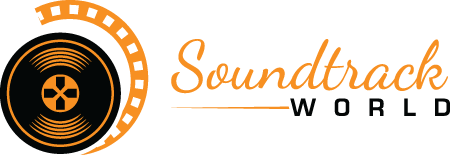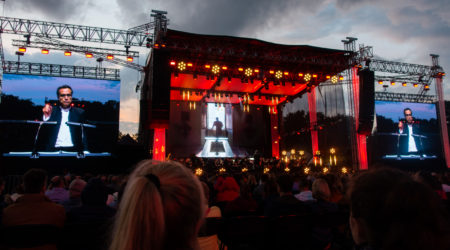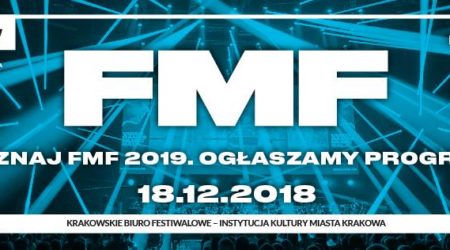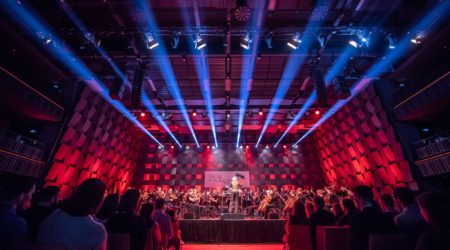During this year’s edition of the Film Music Festival in Krakow, I had the opportunity to have a conversation with Christopher Drake, a talented composer, mainly known for his music for games and animated movies. We talked about how he started his career, scoring for games and about being the Batman composer. The interview took place on June 1, 2018.
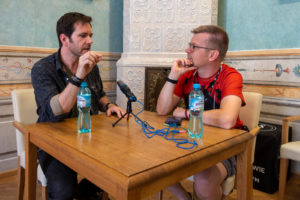 Anton Smit: Hello Christopher, how did you get into this industry as a composer?
Anton Smit: Hello Christopher, how did you get into this industry as a composer?
Christopher Drake: That is a cool, interesting and long story that I am going to try and make very succinct and short. I moved to California in 2002, and I love horror, fantasy and science fiction films. There is a man named Bob Burns in California and he is a props collector from all these science fiction films. He has the original King Kong from 1931, the time machine from George Pal and James Cameron gave him the queen alien from Aliens. Every Halloween, my friend would put on these very extravagant recreations of horror and science fiction movies in his front yard for trick and treaters. It is kind of famous in the film community, because a lot of well-known special effects artists would contribute and it felt like you were in a movie. They had a Halloween show based on The Thing from Another World from 1951 where Dimitri Tiomkin did the original score. So they had this recreation of the movie and I scored an homage to Tiomkin. I played the theremin and it was like this 1950s science fiction score. Because Bob is such a well-known person in the Hollywood horror and science fiction genre, we had a special VIP night where people like Frank Darabont, Joe Dante and all these directors would come – and Guillermo del Toro. He heard my music and he said: “We must work together!” He heard that theremin and Guillermo del Toro gave me my break and those were the Hellboy animated films. If you look at any one of my soundtracks, you will see a special “thank you” section and to the day I die, it will say special thanks to three people: Guillermo del Toro, Bob Burns and my friend Paul Prischman, who introduced me to him. Without these people, we would not be having this conversation right now.
AS: You have scored for movies, animation and also for games. Is there a big difference when you compose for games?
CD: Games are a different thing altogether: it is technology-based. I can tell you a very detailed explanation of how I did, for example, Arkham: Origins, but the reality is whatever techniques we used on that game – because of technology – whenever the next Batman game that is going to come out, within the next two or three years, the technology will be even more advanced. Those techniques that I used for that, may be obsolete. You get a new phone every two years because it has newer technology. The same thing with video games, since it is a technology-based medium, the technical integration of music is becoming more and more advanced: there is more space on the game platform or hard drive space and they have higher resolutions. Now we are entering an era of virtual reality, where we now have to think where is the direction of music coming from. These are new decisions that composers never had to think about, where in the sound space an instrument is coming from. It is a different technical concept, and it is also constantly evolving.
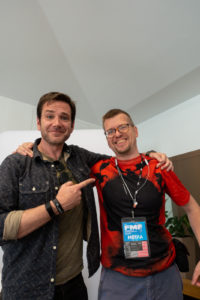 AS: Does this concept also apply to movies and animations?
AS: Does this concept also apply to movies and animations?
CD: In terms of film, television and animation, it is pretty traditional. I am scoring the same way, as Jerry Goldsmith and John Williams. Well, they never had to worry about a mockup, they just play it on the piano and the director trusts them to be on the big stage to prepare with the orchestra. Now we have to mockup the score so that it sounds as much like the final orchestral piece as possible.
AS: For animation, can you write mockups before the images are completely done, or do you have to wait for the finished product?
CD: No, by the time you get involved in animation, and sometimes even with video games, I can start earlier. I did an Injustice game where the animation was not finally rendered, what’s called an animatic. So yes, it can be crude, sometimes even stick figure drawings filling in scenes: a very crudely animated kind of pencil drawings.
What happens in the animation process: They first record the actors and then they take the dialog and the artist’s storyboards, in this case in California, and then send them to Korea or Japan, where then it is animated for almost a year. Then it starts coming back slowly, as soon as we start getting those deliveries of the final animation. As I am writing, those animatics are then replaced with the final thing. The visuals are evolving, as I am writing, from very crude stick figures and black and white drawings. I never see the final animation, there is usually an element of CG for the last pass by the time I am done writing the music, and the music is finished. That is another evolutionary thing when it comes to animations. It is very crude and you never see the final thing. You are writing to animatics.
AS: While you are writing to stick figures and the animations are evolving in the meantime does it change your vision of the music?
CD: The answer is yes. For me personally, I am very visually inspired. The way I would approach scoring music to a scene can be affected not only by the story, maybe the actor’s performance or the way a scene is lit: is it lit with hot red light, that creates some kind of emotion that would make me want to support that with music. I am very visually driven, so it can be a little frustrating when you are looking at these very crude black and white images and you try to imagine what the final thing would be. In that case, what I usually do is ask the company or the audio director if they have any production art. I am not talking about animation, I am talking about paintings: what is the costume design. If this is an alien planet if they could show me a painting how it looks like and that helps me visually and inspires me to create and support that storytelling.
AS: When I look at your recent work, you have written a lot of music for the superhero Batman. However, the music is very diverse. Could you elaborate on that?
CD: At the time I was the only Batman composer that had this specific problem in which I have done five or six different Batman movies. Each one of those movies is not in any continuity with the other ones, whereas Danny Elfman got to reprise his Batman theme in his two films, Hans Zimmer got to reprise his Batman thematic material, and Shirley Walker got to reprise her Batman theme for multiple animated iterations of that character. I had to reinvent the wheel as it is. I always make the joke that I have run out of minor chords. Because each one of those films, I cannot repeat myself. Even if I feel like I have created the best Christopher Drake Batman theme that I am happy with, and that I feel is my expression of what that character is, I cannot repeat it: it is locked in that film and I have to come up with something else. Even Hans Zimmer did not have that problem with Batman v Superman, because he relegated that to Junkie XL. He did not really touch the Batman music. Even my friend Freddy Wiedmann who is doing a lot of the new Batman animated things, since I have kind of stepped back from that, does not have this problem. As soon as I leave, the movies are in some kind of continuity, so Freddy gets to repeat his thematic material. I guess it is a unique thing for me at the moment. It keeps you on your toes, but sometimes it gets a little frustrating. I was very happy with The Dark Knight Returns theme, because I love that comic book and I love that movie. I feel like if I was going to go on a Batman animated thing, that would be the one to go out with. At least I feel like I finally found something that sticks, and it was so satisfying for me.
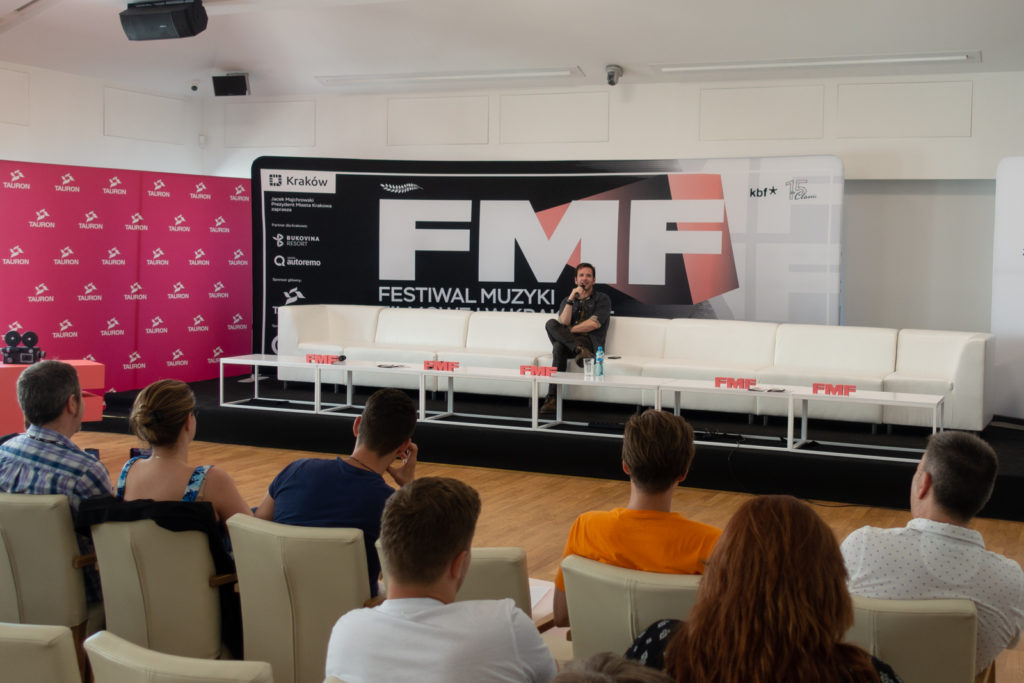
AS: But why are you the Batman composer? It must have started somewhere.
CD: Elliot Goldenthal and Hans Zimmer are geniuses, but I think they do not give a damn about comic books. I doubt that any of them have ever read The Dark Knight Returns. Maybe that is an asset, because they have no preconceptions of the character. It is just an interesting project to work on. They can be creatively liberated of any preconceptions of what the music should sound like. Since I was a kid, my grandmother would yell at me because I would take her blue towels and a safety pin, pin them to my shirt and run around as Batman – jumping around on sofas. My grandmother would yell at me because she was afraid I would break my legs running around. I love the character.
My work on the Hellboy animated movie was my big break that Del Toro gave me. Bruce Timm, who was the director and producer of the original Batman animated series, saw that, and he really liked my work. Because I am a huge Batman fan, I knew all about Bruce Timm: I had Bruce Timm art books and I love the Batman animated series. I think Shirley Walker’s music was just amazing and cinematic on a level that I do not think had ever been achieved at that point. So when the head of music from Warner Brothers calls me up to tell me about a meeting with Bruce Timm, I am like “Oh my God, Bruce Timm!” I tried to play it cool, because I wanted to be a professional and not a fan. She said that Bruce heard my music on Hellboy and would be interested in doing a demo for a new direct-to-video animated film. I did the demo, Bruce loved my work and I was hired, and that started our relationship. For the next six, maybe seven years we worked together on various things. It pretty much bounced between me and Robert Kral. We kind of handed off, because a lot of these movies are happening at the same time, so there is overlap. I cannot do both of them at the same time. I would do a Batman movie and Robert would do a Green Lantern, I would do Wonder Woman, back and forth. So that is how I got involved with Batman.
I think also that Bruce knew that I was a fan. It made it easy for me to work with Bruce. He does not have to tell me that Waylon Jones is Killer Croc. I know all the characters, I know all the backstories and I have read all the stories: many times at the editations I knew Batman: Year 1 and The Dark Knight Returns in and out. During the spotting session, where the composer and director watch the film for the first time, most of the time we did not really talk, because Bruce just knew I knew what to do. He did not really give me a lot of direction. The irony about this is, for The Dark Knight Returns the movie takes place in 1986, and I pitched this analog synthesizer, John Carpenter, Vangelis and Giorgio Moroder concept. Bruce was a little worried. Which is funny because now you hear this nostalgic ‘80s synthwave thing a lot in modern films, especially in American independent horror. But this was before the movie Drive came out and kind of brought that ‘80s nostalgia back. Bruce was concerned that it was a too old-fashioned setting if I scored it like a John Carpenter film. Modern audiences would not get it and think it would be cheesy, and I said that if you just commit to it with sincerity, it will be fine: it would help it to stand apart from all the other orchestral, minor chord, Wagnerian, Batman things. We spoke the same language, and that was the only time we really had a kind of debate about if it was a risky idea and in the end, my idea went out and that is how that score was made.
AS: To conclude this interview, what can we expect from you in the near future?
CD: This is kind of a bummer, because I am in the process of negotiating a deal with a couple of projects that I cannot mention anything about. They are secret projects as of now.
AS: But we will hear from you in the near future?
CD: Very much so!
